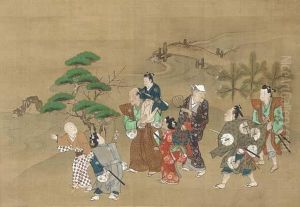Hishikawa Paintings
Hishikawa Moronobu is a well-known artist considered to be the father of ukiyo-e, or Japanese woodblock printing. Born in 1651, Moronobu was a native of Awa Province, which is in modern-day Chiba Prefecture. His exact date of death is not well documented, but it is generally believed that he died around 1713. Moronobu came from a family of embroiderers and dyers, which likely influenced his understanding of design and aesthetics from an early age.
Moronobu moved to Edo (now Tokyo) in his twenties, where he studied painting and eventually established himself as an artist. He initially worked creating illustrations for books, particularly kyōka (humorous poems) anthologies, and eventually became known for his single-sheet prints. Moronobu's work is characterized by its lively line work and clear compositions, often depicting scenes from the pleasure quarters, kabuki theater, and daily life of Edo's chōnin (townspeople).
Moronobu was prolific and his contributions to the development of ukiyo-e were significant. He was the first to produce full-size single-sheet prints that depicted both figures and narratives, setting the standard for future ukiyo-e artists. While Moronobu's prints were monochromatic, his careful use of line and ability to depict fabric and textures laid the groundwork for the polychrome prints that would become popular later in the Edo period.
Moronobu's influence extended beyond his lifetime, as he left a lasting legacy on the ukiyo-e genre. His studio continued to operate after his death, and he had numerous followers who helped perpetuate his style. Although the exact circumstances of his death are unclear, Moronobu's artistry remains well-respected, and his prints are still studied and appreciated today for their historical and artistic value.
